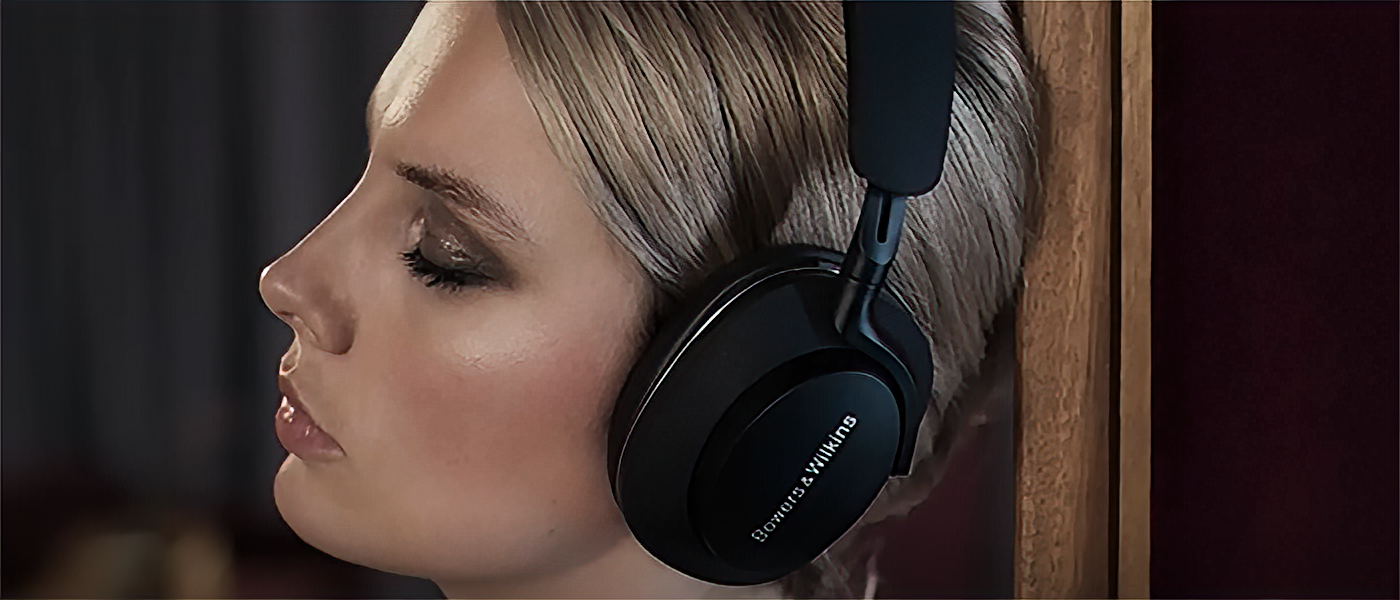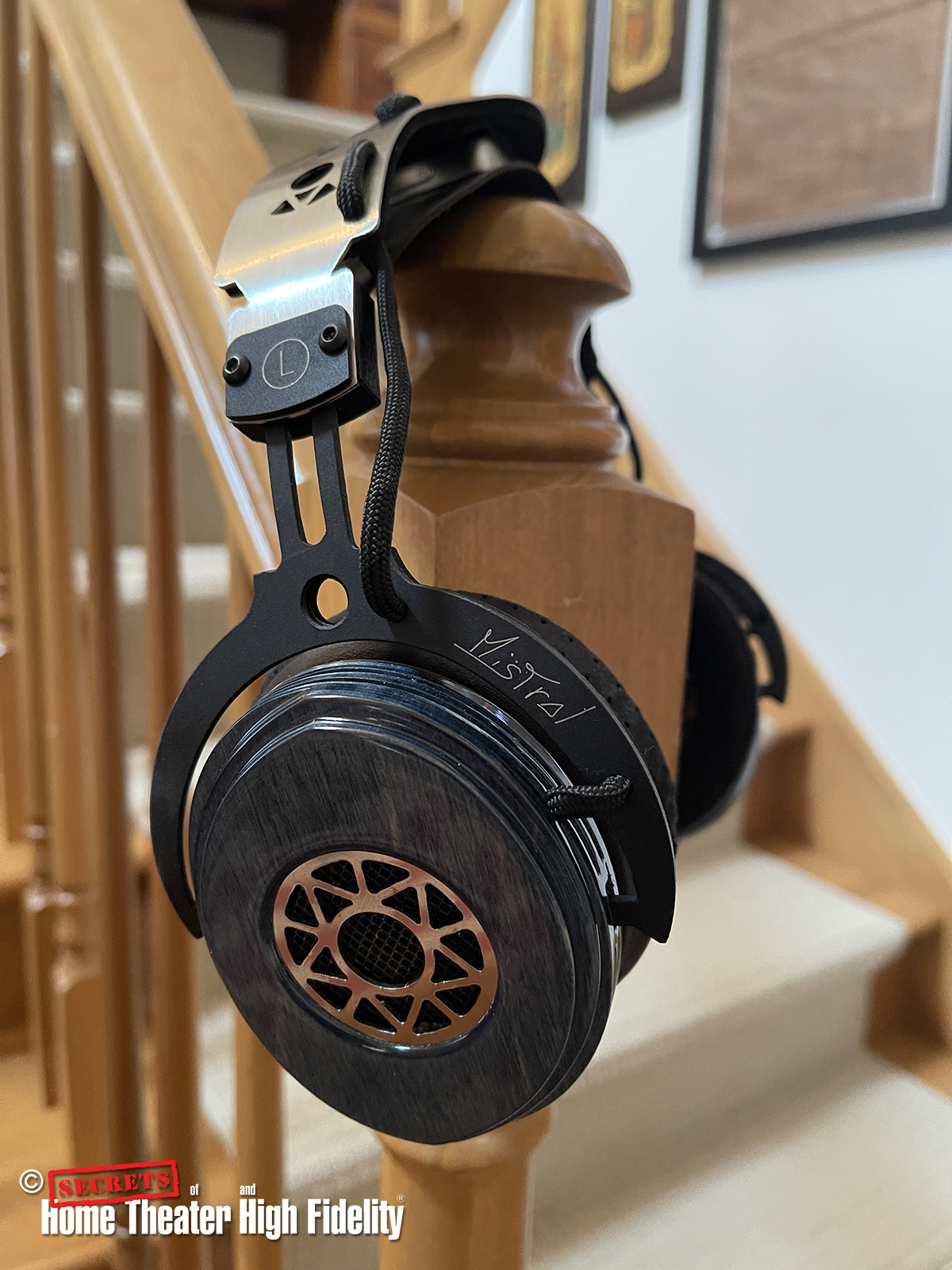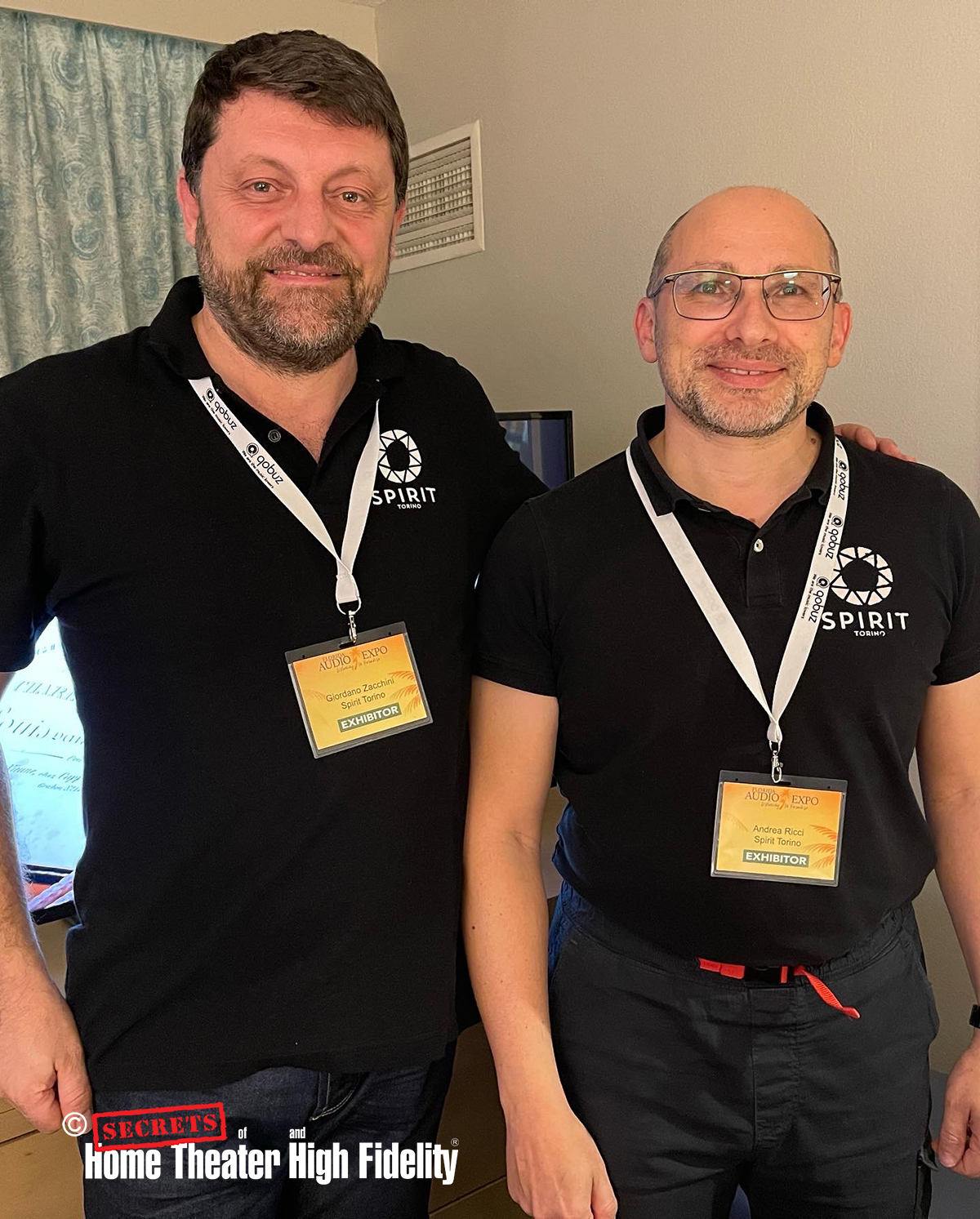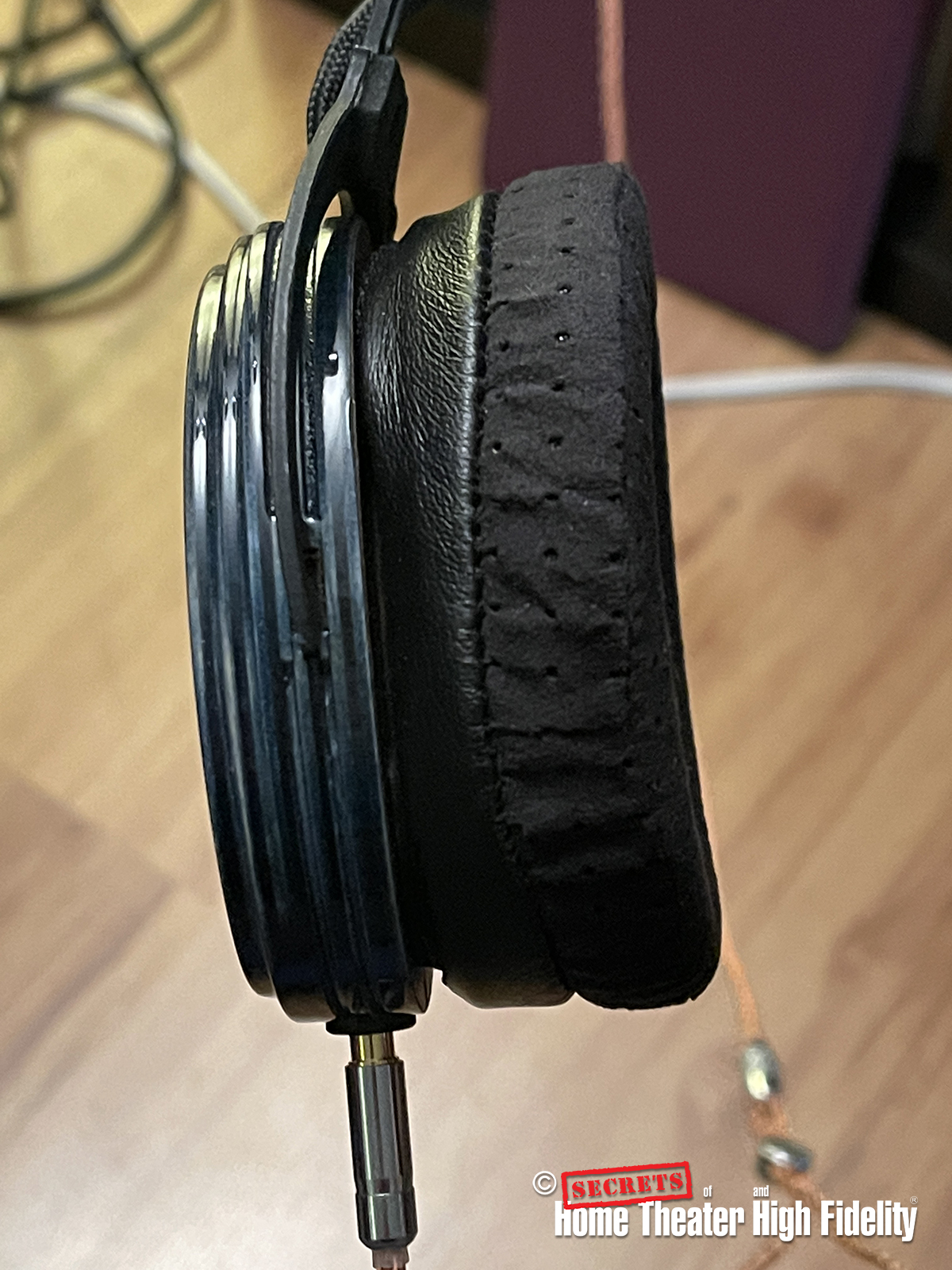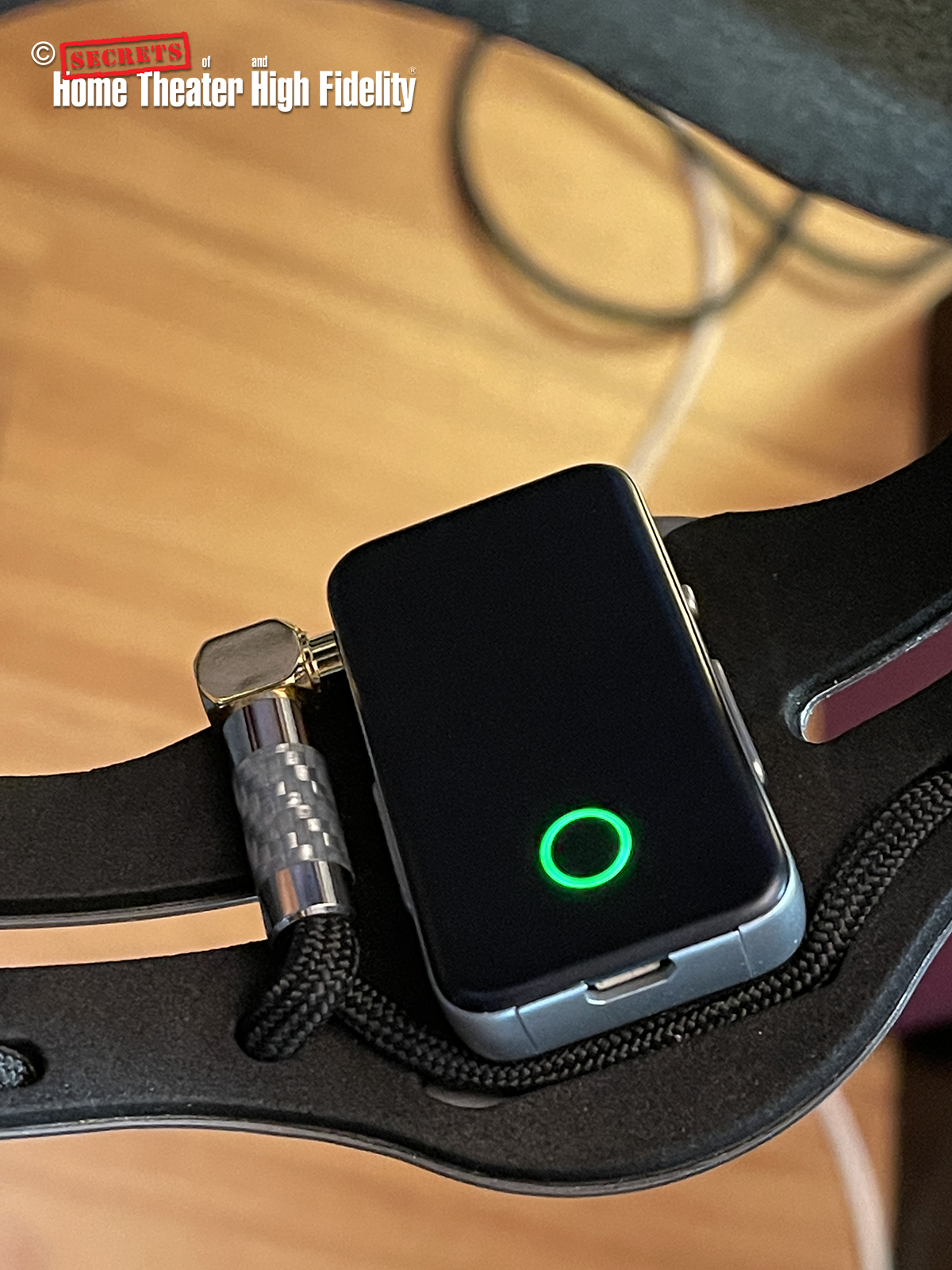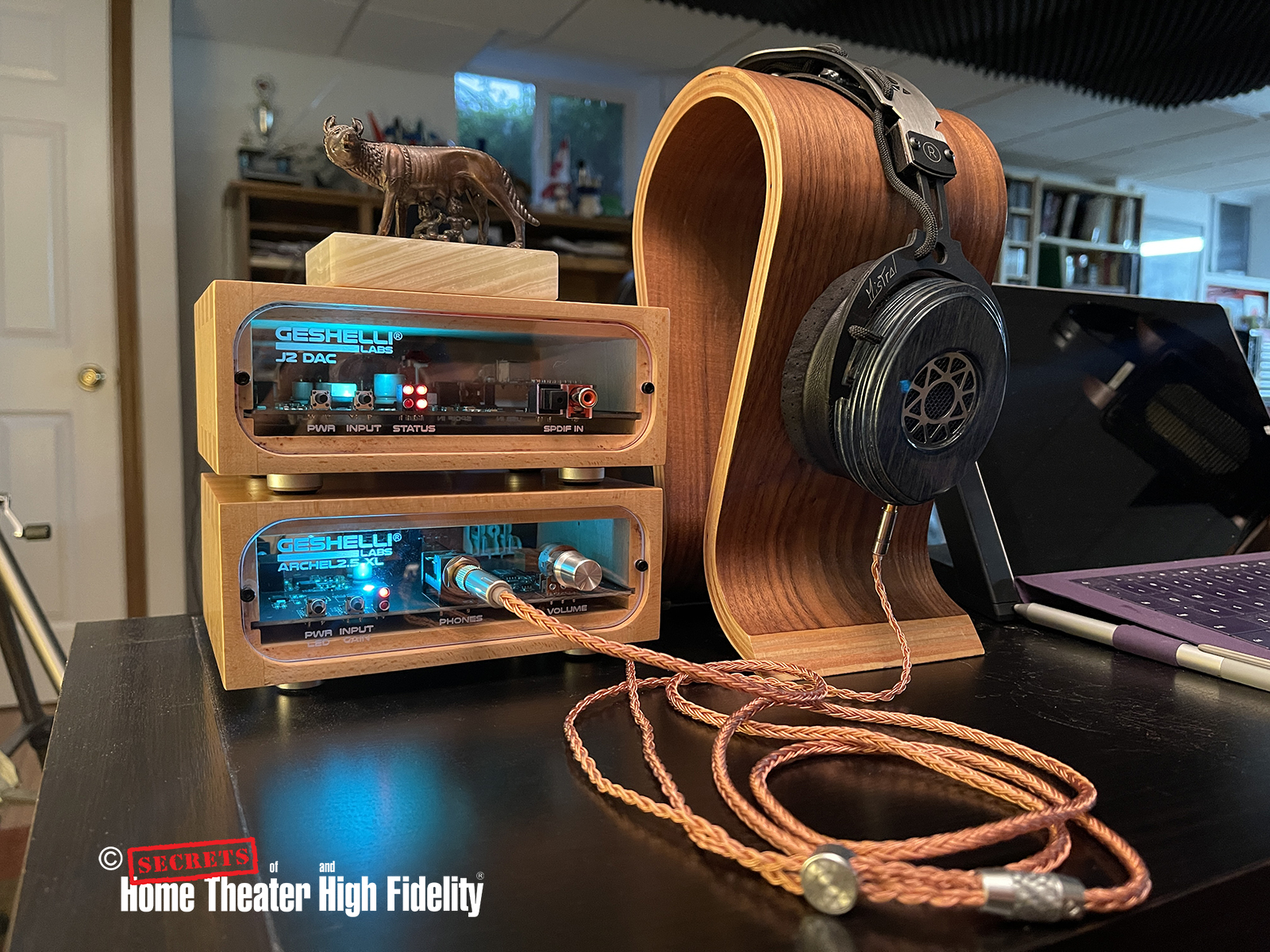The Spirit Torino Mistral Bluetooth is a unique take on the concept of the Bluetooth headphone. Designed and manufactured in Italy, they look and sound like no other wireless headphones out there.
Spirit Torino Mistral Bluetooth Headphones Highlights
- Lively and engaging sound with solid bass response.
- Sound signature is detailed without sounding overly peaky in the treble.
- Integrated EarStudio ES100 Mk2 Bluetooth receiver has great sound and a wealth of options.
- Headphones sound even better when run wired.
- Handcrafted design with multi-layered birch earcups.
- No noise cancellation feature or carry case.
While I have sampled my fair share of headphones over the years, I was unfamiliar with the Spirit Torino brand until I stumbled across their room at Florida Audio Fest this past January. There I was introduced to Andrea Ricci (Spirit Torino’s CEO and Chief Designer) and Giordano Zacchini (President and COO).
After we had a good laugh at how rusty my spoken Italian was, the duo gave me a thorough history of the company and described its product line along with its mission. Started by Ricci in 1993, the company began life creating furniture and Hi-Fi accessories for the local Turin Hi-Fi shops and clients. Over the years the brand expanded into binaural recording, collaborations with local recording studios, and then headphone customization. The creation of a record label soon followed and finally the ground-up design and fabrication of headphones and associated electronics. Spirit Torino (Torino being the Italian pronunciation of Turin) currently has just over a dozen headphones in their product lineup with the Mistral Bluetooth being the most affordable. All Spirit Torino headphones are designed and assembled in Italy with an emphasis on most of the production work being done by vendors local to the Turin area. According to Andrea Ricci, Spirit Torino’s goal is to design headphones that do nothing to alter or impede the natural sound of the music as intended. He also regards the designing of headphones not as simply making a mechanical reproduction device but more like designing a musical instrument. This goal is a shared view of many in the Italian audio industry. Where have we heard this before? Hello? Sonus faber anyone?
So, with all that being said, is the Spirit Torino Mistral Bluetooth something truly unique and special compared to other similar headphones out there? Time to find out!
Design:
Circumaural, semi-open-backed headphones with dynamic drivers and an integrated Bluetooth module.
Driver:
40 mm dynamic driver with Mylar diaphragm.
Frequency Response:
20 Hz – 28 kHz (Manufacturer)
Impedance:
32 Ohms
Sensitivity:
96 dB
Weight:
350 grams
Bluetooth Module:
EarStudio ES100 Mk2 Bluetooth receiver in the headband.
Bluetooth Version:
5.0
DAC Chipset:
Dual AKM AK4375a
Supported Codecs:
LDAC, aptX, aptX HD, AAC
Warranty:
2 years
Accessories:
1.3-meter detachable headphone cable, 6-inch USB charge cable.
MSRP:
$807.50 USD
Website:
SECRETS Tags:
pirit torino, headphones, bluetooth, mistral, italian, design, Headphone Review 2022
The Spirit Torino Mistral is visually about as unique-looking a headphone as they come. The combination of the laser-cut stainless-steel headband, anodized black steel yolks, integrated braided wiring, Bluetooth receiver, black leather head-strap, stained birch wood earcups, and ventilated Alcantara earpads, make these headphones look like they came out of the pages of a Rocketeer comic or a Steampunk convention. Aesthetically, the detailing and quality of the materials are excellent. A nice change from soft-touch plastics and memory foam that are found in many similar products. There is no mistaking that the Mistrals have a strong visual personality.
Technically the Spirit Torino Mistral uses 40 mm dynamic drivers, with mylar diaphragms. The drivers are set inside earcups made from several layers of laser-cut birch that are stacked together. Each layer is cut with a different sized internal opening and grooves so, when combined, it creates a specifically designed tuned chamber with strategic ventilation. The chamber is also lined with felt and a specialized dampening material called Dynamat. Continuing the theme of layers, the earpads (made in cooperation with earpad specialist Dekoni) are also composed of layers of ventilated Alcantara, and leather.
The integrated Bluetooth receiver is the EarStudio ES100 Mk2 and it is mounted in the top of the headband. Functionally the Mistral takes a lesson or two from the HIFIMAN Deva (and Deva PRO). That being they are a fine-sounding pair of passive headphones in their own right, mated to a separate/detachable Bluetooth receiver and DAC. The receiver is hardwired to Mistral’s drivers via the EarStudio’s 3.5mm single-ended headphone jack. There is an unused 2.5mm balanced headphone jack on the EarStudio as well. I asked Andrea Ricci why the balanced output wasn’t used for Bluetooth playback. His reply was that it came down to a choice between the relatively modest gain in sound quality using the balanced jack over the major gain in battery life by using the single-ended jack.
The ES 100 Mk2 has an app you can download to access the equalizer, different DSP features, digital filters, battery life indicator, and volume control. The volume control is interesting as the app controls both the digital volume control of my iPhone and the “analog” volume control of the ES 100 Mk2. The recommended operation for best sound quality, when connected by Bluetooth, is to keep the smartphone volume maxed out while relying on the analog volume slider in the app for ultimate listening volume. Be warned, if you have an iPhone as I do, the electronic nanny within the health app will be sending you constant alerts that your listening volume is too loud. It won’t be as it is just referencing its own maxed-out volume setting.
Secrets Sponsor
The unit also has a built-in microphone allowing for hands-free phone calls when connected to a smartphone. The ES 100 Mk2 works with aptX, aptX HD, LDAC, and AAC Bluetooth codecs. It also uses two AKM AK4375a DAC chips (one per channel) for lower distortion and a better signal-to-noise ratio overall. Neither the Bluetooth receiver nor the headphones offer any kind of active noise cancellation feature.
It should be noted that Spirit Torino also offers the Mistral in both a closed-back and non-Bluetooth versions as well.
Accessories included are a handsome 1.3-meter-long braided copper headphone cord and a short USB charge cable for the Bluetooth receiver.
Battery life is advertised at up to 14 hours of playback from a full charge.
During my review, the Spirit Torino Mistral was used/paired with the following equipment.
Desktop: Topping DX7PRO DAC/Headphone amp, Geshelli Labs J2 DAC and Archel 2.5 XL Headphone amp, Benchmark Media Systems DAC3 B and HPA4 Headphone amp.
Mobile: Apple iPhone 12 Pro Max, Shanling M0 DAP, Topping NX4 DSD portable DAC/Headphone amp, THX Onyx DAC dongle.
At 350 grams the Spirit Torino Mistral Bluetooth headphones are light and comfortable, so long listening sessions remain a pleasurable experience. Clamping force is light to moderate, which is fine, but after a week or two of steady use I was noticing the headphones seemed a little loose on my head, sliding around a little more than I’d like. An occasional gentle flex of the stainless-steel headband brought the tension back to a desirable level. The company states that this is by design so that the headband can be easily adapted to multiple head sizes. The vented Alcantara earpads are extremely comfortable and did not get my ears overly hot while out walking the dog or doing lawn work, and they completely fit around my earlobes and provided a good seal. For semi-open headphones, they leak just a little bit of sound, as you would expect, but nowhere near the amount that open-backed planar headphones do. So, it shouldn’t be an issue wearing them in busy public spaces. By the same token though, you will have outside sounds intrude somewhat on your listening but not bad overall.
As a side note, Spirit Torino has loads of marketing materials with beautiful, young, and fashionable urbanites enjoying their headphones in trendy locales. That is all well and good for marketing, because I’m sure the more typical users of these headphones (that being husky older audiophiles listening to their music while gardening) probably doesn’t have the same cachet!
When speaking with Andrea and Giordano at Florida Audio Fest, they explained to me how the sound signature and tonal balance of Spirit Torino headphones are informed by input from a panel of musicians that work with the company. The idea is that more than anyone, they know how instruments should sound when reproduced. This, along with Andrea’s experience in binaural recording, set the tuning strategy for the various headphone models Spirit Torino offer. Their efforts most certainly pay off as the Mistral Bluetooth have a sound quality that is exceedingly natural and quite alive with whatever music that I sampled with them. The timbre and tonal quality of various instrument sounds appear as full and lifelike as I can imagine them, given my experience and references. The sense of space or atmosphere of the music seems to successfully extend outside the confines of the earcups but not so much as that it feels artificial. The bass response felt deeper and more solid than I was initially expecting, with vocals and instruments sounding nicely balanced, and with a pleasingly clean treble character.
Secrets Sponsor
At 32 ohms the Mistral Bluetooth are relatively easy to drive wired by most portable devices or capable dongle DACs like the THX Onyx. Sound quality-wise, the Topping NX4 DSD was a great pairing, with plenty of headroom available on the Low-Gain setting. And with hundreds of tracks on my little M0 DAP that was strapped to the Topping, it made for a superior mobile listening arrangement.
Switching between wireless Bluetooth and wired use, showed that wireless performance was cleaner than most other wireless headphones that I’ve tried, bettering my favorite DALI IO6 by a little bit. AAC sound quality with my iPhone 12 was also right up there, very appealing to listen to on daily walks with my dog. There was no real sense of it being a downgrade as in some other headphones. LDAC performance with my Shanling M0 was perhaps sonically better than the iPhone but completely impractical because the limited transmission range of the M0 meant I needed to Velcro the little player to the top of the headband to keep the wireless connection solid. And while I didn’t expressly track the Bluetooth receiver battery life, I would routinely charge the unit every week-and-a-half with about 20 percent left on the battery. My typical usage was between 1 to 2 hours each day.

Jeff Baxter with Michael McDonald “My Place in the Sun”
This song has been a lingering earworm for me since I first got this excellent CD last month. Overall chock full of great tracks, “My Place in the Sun” is an emotive ballad featuring Michael McDonald’s trademark vocals and Jeff Baxter doing some tasteful and expressive solo work on lead guitar. Mc Donald’s voice sounds full, yet detailed and easily reveals an older, dusky, wiser character, still capable of plenty of power, along with nuance in his singing. Baxter’s guitar fills and solos mostly feature a chunky, ringing tone with an almost crystalline quality to the higher notes. The Mistrals did a great job of capturing these details appealingly over a wide synthesizer background. Pairing the Mistrals with the Geshelli Labs J2 and Archel 2.5 stack (review coming soon) for this track was exceptionally good. I can see why the Spirit Torino guys used this setup at the Florida, New York, and Chicago shows this year.

Christian McBride, and Russel Malone ”Conversations with Christian”
Christian McBride’s bass playing had great depth of tone and I could certainly feel the tension of the plucks, but the Mistrals also portrayed a sense of agility and speed to the notes that I found interesting. When listening to the same song with the closed-back Dan Clark Aeon 2 Noir, the bass notes were heavier and denser. They hit with a little more impact but with not quite as wide a sense of spaciousness. I assume that is mostly due to the closed-back design of the Noir. Russel Malone’s guitar playing shimmered through both headphones, light, airy, and with a great ringing sound in the decay. Bluetooth listening, with the ever so slightly smoother presentation from my iPhone, was a winner on this track.
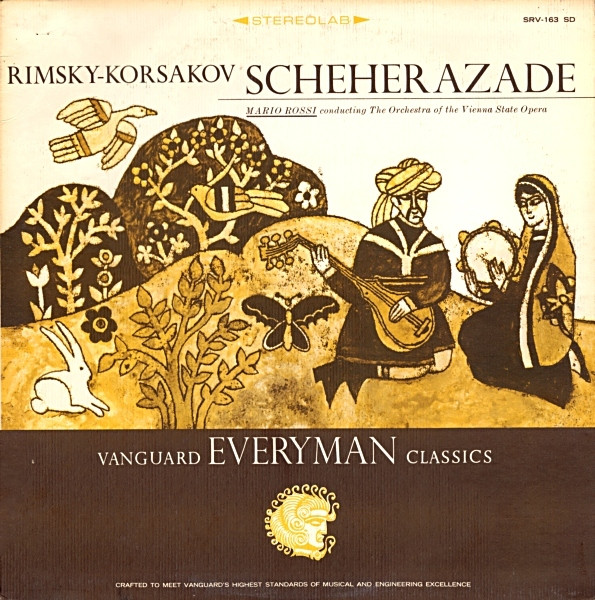
Rimsky-Korsakov “Scheherazade”
While I love both the classic RCA recording with Fritz Reiner and a more recent recording by Phillips with Valery Gergiev, this late 50s version with Mario Rossi conducting the Vienna State Opera is the first version of Scheherazade I ever heard and the one I fall back on. I love the pacing of it and while not the most “audiophile” of recordings, the Mistrals kept it sounding expansive and dynamic. The opening violin and harp sound so sweet and appealing. Then as the woodwinds come in and the rest of the orchestra swells, the Mistrals just make it all sound huge. The dimension of the recording space comes across clearly. Even at the recording’s age, the Mistrals clearly reveal the layers of instruments and details in a clear and appealing manner. The Benchmark HPA4 and DAC3 B stack meshed so well with the Mistrals on this track (and frankly all the others). It was decidedly the best-sounding hardware combo with these headphones out of anything I had.
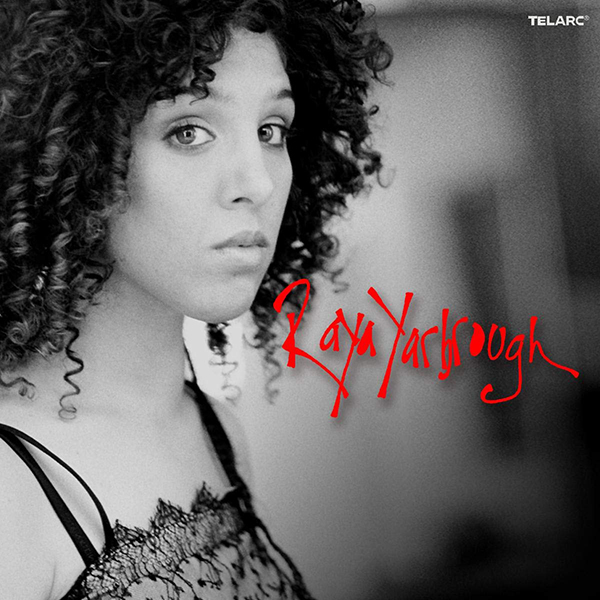
Raya Yarbrough “Dreamer’s Ball”
Miss Yarbrough’s vocals sound clean and pure through the Spirit Torino Mistrals with an excellent sense of both body and detail. When her voice hits the high notes, it sounds extremely clear and without any sort of harshness. The background singers on the song fill out the sound space, extending well outside the earcups. The accompanying finger-picked acoustic guitar has great texture and detail to the sound of the strings as they are being picked and strummed. A lot of times “clear-sounding” headphones can come across as thin-sounding or lacking in mid-bass. The Mistrals strike a nice balance, so female singers that operate at a generally higher pitch than say, Diana Krall’s fuller tones, sound nicely balanced and pleasing to the ear. The Topping DX7Pro was an excellent combo on this one.
I only have one other semi-open back headphone around to directly compare and it’s much less expensive, so it won’t entirely be a fair comparison. I’m also evaluating the Mistrals as a nicely designed pair of passive headphones with Bluetooth capability as an added option. They are not like the DALI IO6, Sony WH-1000M5, or B&W PX7 s2 ANC (Active Noise Cancelling) headphones because they don’t offer noise cancellation and don’t actively use DSP to tune the final output at the drivers.
The closed-back Dan Clark Aeon2 Noir (https://hometheaterhifi.com/reviews/headphone-earphone/dan-clark-audio-aeon-2-noire-headphone-review/) is at a similar price point and is similarly clean and detailed sounding with perhaps a touch more fullness in the mid-bass. Vocals are also a little farther back in the soundstage. Their closed-back design also constrains the soundstage a bit by comparison to the Mistrals but I do like that they block out a huge amount of external noise leaving me with just the music to listen to. They are a little harder to drive as well. Overall, not as immediate as the Mistrals or even the T5 Gen 3 further down, but well balanced from top to bottom and they are the headphones I like to travel with the most.
The Beyerdynamic DT880PRO-250 Ohm is the other semi-open design headphone I have and while sounding decent on their own, they sound a little thin and flat in comparison to the Mistrals. The Mistrals sound richer and more alive, with more dimension to the music, along with a superior bass response. Again, the DT880PRO is an older model and at 1/3rd the price of the Spirit Torino cans, not really a fair comparison beyond the design similarity.
The Beyerdynamic T5 Gen 3 is a closed-back design that is just a little more expensive than the Mistrals. While they are a closed design, their Tesla drivers do a fantastic job in creating an extra sense of spaciousness, although not to the same degree as the Mistrals. Power-wise both are almost identically easy to drive. The Beyerdynamic’s overall sound signature is slightly more refined and smoother than the Spirit Torino’s more lively and immediate presentation. In my mind, it’s kind of like comparing the sound of a fine tube amp (T5 Gen 3) to the sound of an equally fine solid-state amp (Mistral). The T5 Gen 3 also makes a great all-around headphone and is easy to travel with.
All the headphones have comparable bass depth and quality save for the DT880 PRO. They have the lightest bass impact of the cans I’ve compared here.
Very musical, very stylish, and very unique. As wireless headphones go, the SPIRIT TORINO MISTRAL BLUETOOTH is a fantastic sounding breath of fresh air.
- Excellent comfort.
- Spacious, alive sound quality.
- An appealing level of bass.
- EarStudio Bluetooth receiver offers excellent wireless performance.
- Sounds fantastic wired or wireless.
- Made in Italy.
- A hard-shell travel case included in the package.
I think that Spirit Torino has found an interesting niche in the seemingly ever-growing headphone landscape. A uniquely styled product line with interesting, applied technologies, and all handcrafted in Italy makes for a very compelling brand presence to stand out from the crowd. They also have a certain level of confidence in what they are doing to offer headphone models not just in the Mistral’s price bracket but their $5,000 Pulsar and $11,000 Valkyria Titanium models too. I’ve heard both those models at past shows and there is some serious “WOW” factor coming from them, both visually and in the sonics. However, coming back down to earth and talking about the Mistral Bluetooth, I find that they are an exceptional pair of headphones. The Bluetooth implementation is extremely clever and works very well. They are very comfortable to wear for very long periods of time, both indoors and out, and the quality of materials and styling is unlike anything else. They do not feel like a mass-production commodity; they look and feel hand-crafted in the best sense of the term. Finally, we come to the sound quality, of which I can find little to fault. They sound spacious and alive with plenty of detail and bass in their presentation. Vocals almost float but still have plenty of body to them and they don’t bury themselves inside my head. The Mistrals are very much a pleasure to listen to with all types of music and are generally easy to drive. My only real complaint about the Spirit Torino Mistral Bluetooth is that they don’t fold up or come with any sort of travel case to make taking them on a plane or train easier. I know I would feel uncomfortable just tossing them in my carry-on bag as they are. C’mon guys, I know Italians can make a dynamite matching travel case for the Mistrals! In all seriousness though, if you are looking for a great and frankly appealing sounding pair of headphones and want high-performance Bluetooth in the bargain but aren’t needing noise cancellation, the Spirit Torino Mistral Bluetooth is highly recommended.


